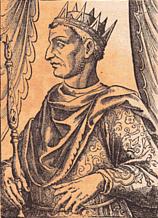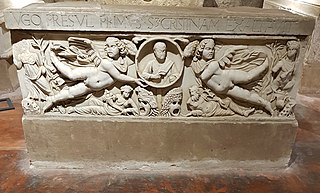
Pope Adrian IV was head of the Catholic Church and ruler of the Papal States from 4 December 1154 to his death in 1159. He is the only Englishman to have been pope.

Pope Victor III, was the head of the Catholic Church and ruler of the Papal States from 24 May 1086 to his death. He was the successor of Pope Gregory VII, yet his pontificate is far less notable than his time as Desiderius, the great abbot of Monte Cassino.

Year 1156 (MCLVI) was a leap year starting on Sunday of the Julian calendar.

The Battle of Benevento was a major medieval battle fought on 26 February 1266, near Benevento in present-day Southern Italy, between the forces of Charles I of Anjou and those of King Manfred of Sicily. Manfred's defeat and death resulted in Charles' conquest of the Kingdom of Sicily, effectively ending the rule of the Hohenstaufen dynasty in the Italian Peninsula and marking the rise of the royal Capetian House of Anjou. The engagement was part of the conflict which pitted Guelphs against Ghibellines.

Roger II or Roger the Great was King of Sicily and Africa, son of Roger I of Sicily and successor to his brother Simon. He began his rule as Count of Sicily in 1105, became Duke of Apulia and Calabria in 1127, then King of Sicily in 1130 and King of Africa in 1148.

Robert "Guiscard" de Hauteville, sometimes Robert "the Guiscard", was a Norman adventurer remembered for his conquest of southern Italy and Sicily in the 11th century.

William I, called the Bad or the Wicked, was the second king of Sicily, ruling from his father's death in 1154 to his own in 1166. He was the fourth son of Roger II and Elvira of Castile.

The Kingdom of Sicily was a state that existed in Sicily and the south of the Italian Peninsula plus, for a time, in Northern Africa from its founding by Roger II of Sicily in 1130 until 1816. It was a successor state of the County of Sicily, which had been founded in 1071 during the Norman conquest of the southern peninsula. The island was divided into three regions: Val di Mazara, Val Demone and Val di Noto.

The Duchy of Benevento was the southernmost Lombard duchy in the Italian Peninsula that was centred on Benevento, a city in Southern Italy. Lombard dukes ruled Benevento from 571 to 1077, when it was conquered by the Normans for four years before it was given to the Pope. Being cut off from the rest of the Lombard possessions by the papal Duchy of Rome, Benevento was practically independent from the start. Only during the reigns of Grimoald and the kings from Liutprand on was the duchy closely tied to the Kingdom of the Lombards. After the fall of the kingdom in 774, the duchy became the sole Lombard territory which continued to exist as a rump state, maintaining its de facto independence for nearly 300 years, although it was divided after 849. Benevento dwindled in size in the early 11th century, and was completely captured by the Norman Robert Guiscard in 1053.

Robert II was the count of Aversa and the prince of Capua from 1127 until his death.
Matthew of Ajello was a high-ranking member of the Norman court of the Kingdom of Sicily in the 12th century. His brother John was a bishop.
The Treaty of Benevento or Concordat of Benevento was an important treaty between the papacy of Adrian IV and the Norman Kingdom of Sicily. After years of turbulent relations, the popes finally settled down to a peace with the Hauteville kings.

Robert of Bassunvilla was the count of Conversano and Loritello. His family had a long history in Vassonville, near Dieppe.

Andrew, count of Rupecanina, was a Norman nobleman of the Mezzogiorno. He was a longtime adversary of the royal power.

Hugh was the Archbishop of Capua in the late 1140s and Archbishop of Palermo from 1150 until his death, probably in 1165–66.
The Treaty of Mignano of 1139 was the treaty which ended more than a decade of constant war in the Italian Mezzogiorno following the union of the mainland duchy of Apulia and Calabria with the County of Sicily in 1127.

The Principality of Capua was a Lombard state centred on Capua in Southern Italy. Towards the end of the 10th century the Principality reached its apogee, occupying most of the Terra di Lavoro area. It was originally a gastaldate, then a county, within the principality of Salerno.
Oddone Frangipane was a Roman lord and military leader in the service of the Papacy in the 12th century.

The Norman conquest of southern Italy lasted from 999 to 1194, involving many battles and independent conquerors.

The Byzantine–Norman wars were a series of military conflicts between the Normans and the Byzantine Empire fought from c. 1040 to 1186 involving the Norman-led Kingdom of Sicily in the west, and the Principality of Antioch in the Levant. The last of the Norman invasions, though having incurred disaster upon the Romans by sacking Thessalonica in 1185, was eventually driven out and vanquished by 1186.